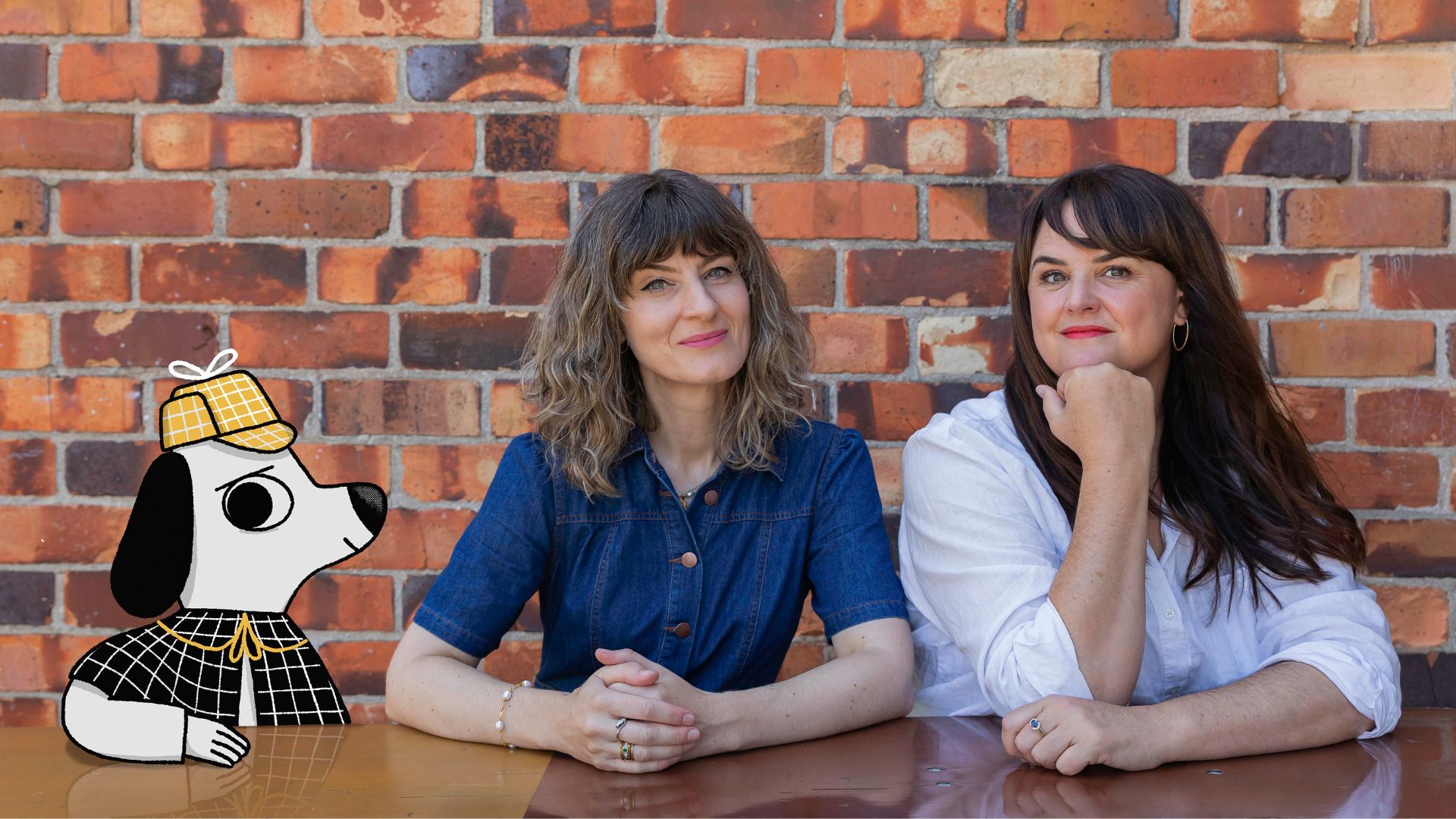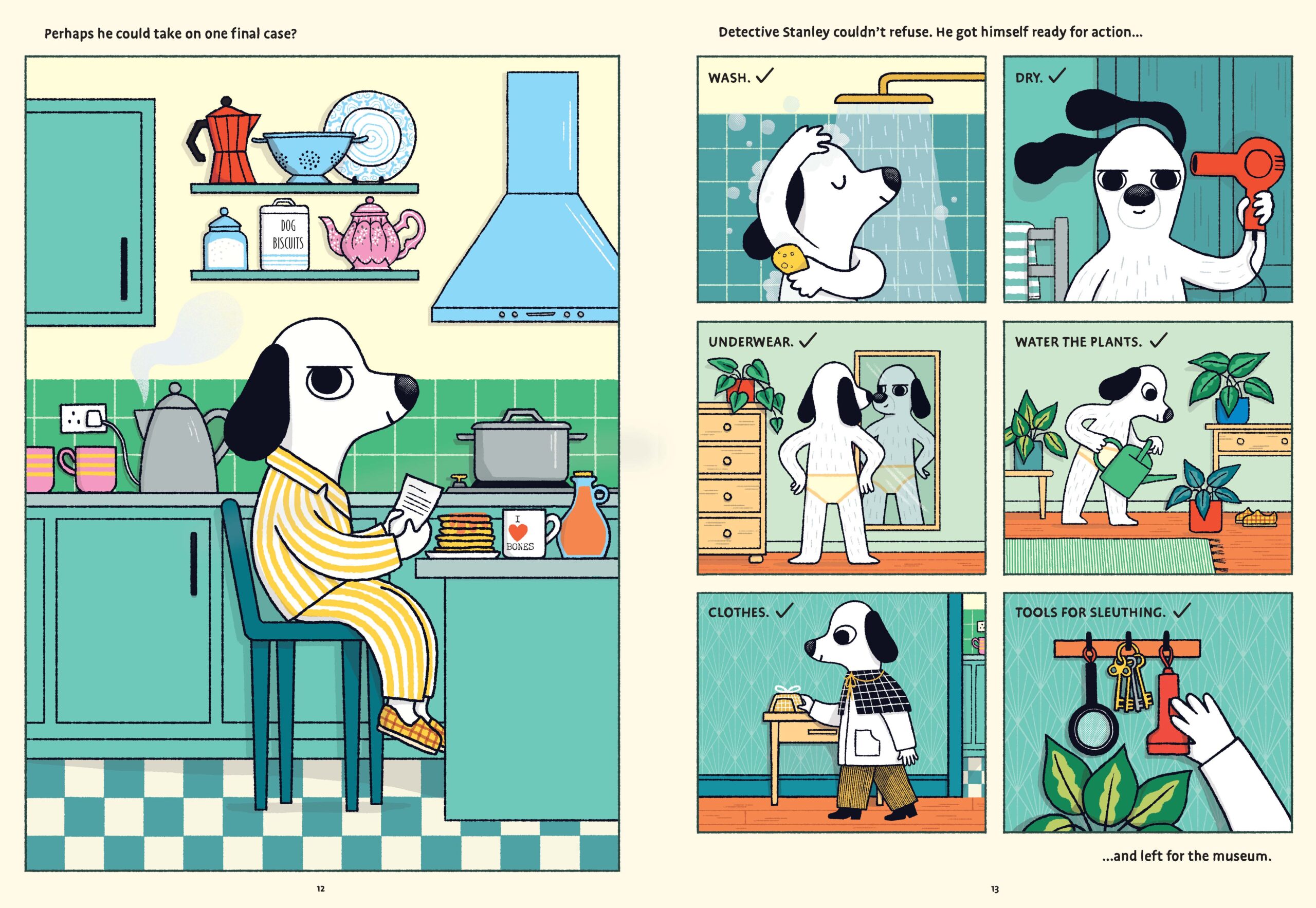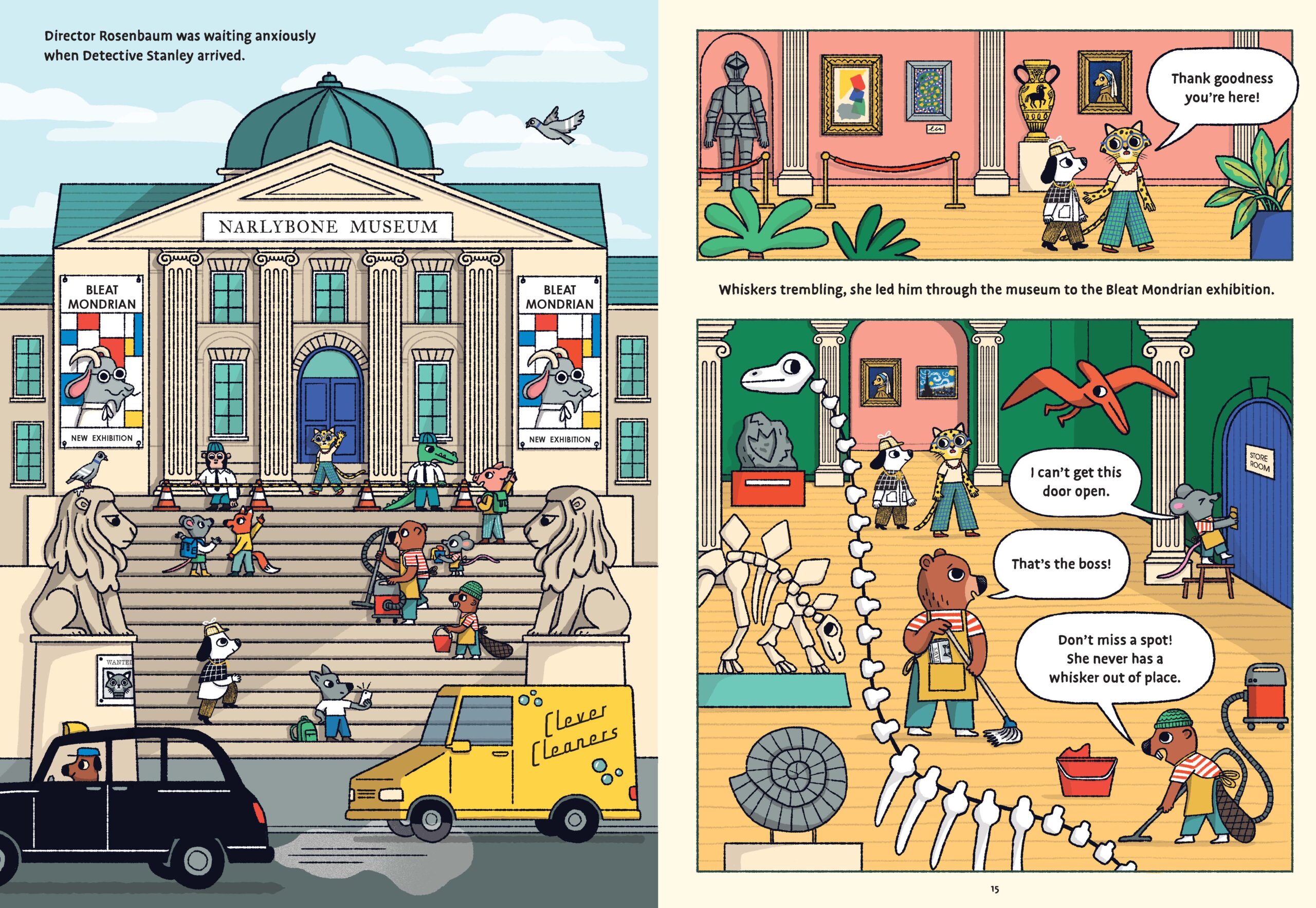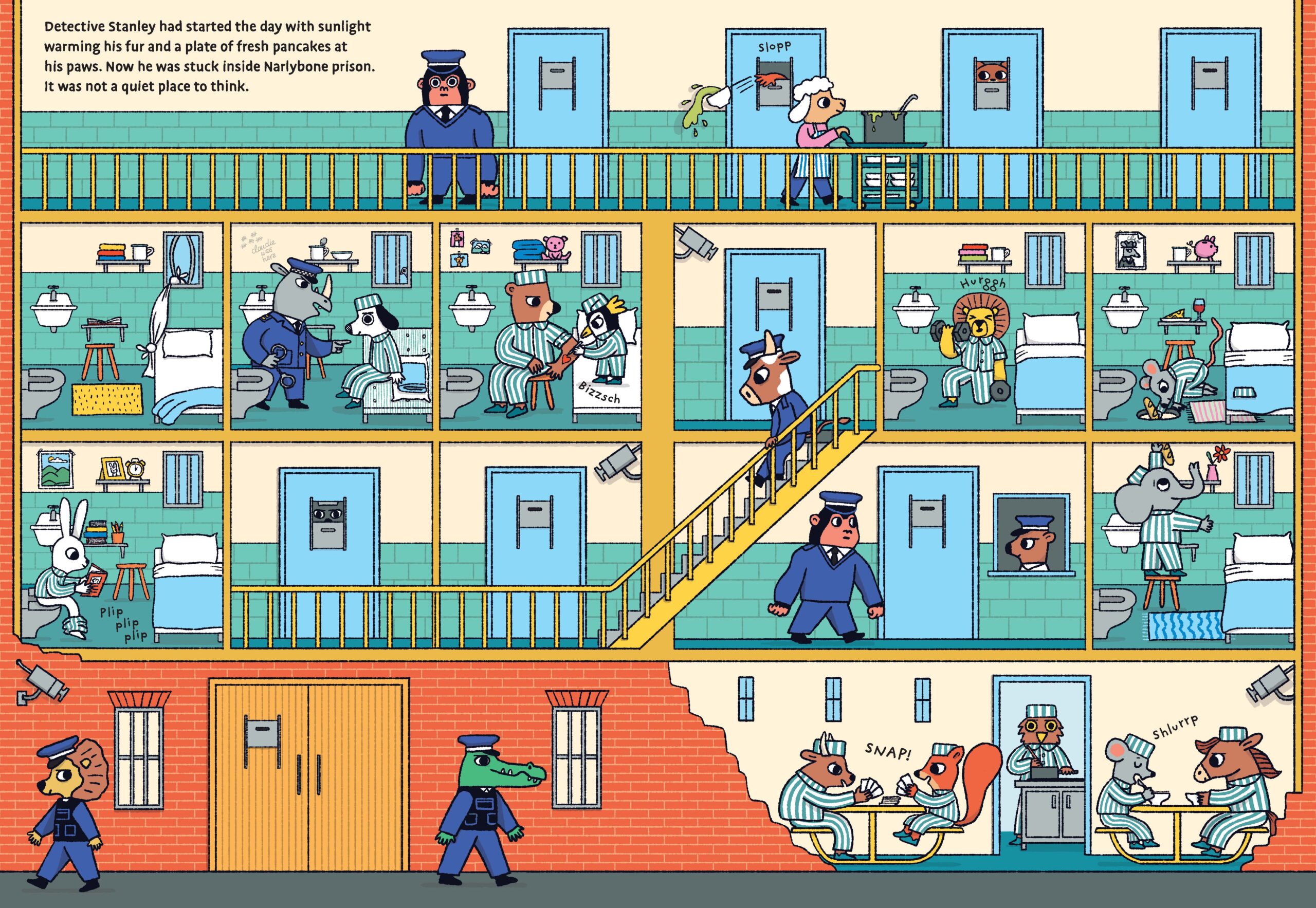Erica Harrison and Hannah Tunnicliffe met at the school gate, and discovered a shared passion for children’s books. They chat with Annelies Judson about their new collaboration, Detective Stanley and the Mystery at the Museum.

I meet Erica Harrison and Hannah Tunnicliffe in Devonport, which seems appropriate. They met each other here, and their first collaboration was an activity book about the history of Devonport. Now they are sitting down with me in a Devonport cafe to talk about their book Detective Stanley and the Mystery at the Museum, which is part of a contract with UK-based press Flying Eye for a series of graphic readers. This artsy suburb of Tāmaki Makaurau seems exactly the kind of place that a writer and book designer/illustrator might meet as mums at the school gate and end up with an international publishing deal.
The book follows Stanley, a just-retired detective who receives a letter at breakfast asking him to come to a crime scene at the museum. Stanley—who is a dog, and lives in a world of anthropomorphic animals—can’t help himself. He loves a good case, and it’s not long before he’s walking in the galleries, trying to work out what’s been stolen. The text draws from the world of detective stories, and the illustration draws from the world of modernist art, but the text also has some great art references (the artist whose work has been stolen is called ‘Bleat Mondrian’) and the art recalls tropes of detective stories, like the old-fashioned detective outfit that Stanley wears. It is clear that there has been a lot of collaboration between the two women.
It helps that both of them are accomplished in their respective fields. Harrison studied illustration at university and has spent years of her career illustrating and designing for kids’ publishers like Usbourne and MudPuppy.
‘I guess I’m not just an illustrator and that’s definitely a bonus,’ she says. ‘I’ve already got a head start on people who are just exceptional illustrators.’ Her Instagram is a glorious ride through bright colours and fun patterns, and the genesis of the Detective Stanley style is evident in projects from years ago. Tunnicliffe is a published writer for adults. Her most recent book, The Pool, was published by Australian-based Ultimo Press. So while writing a graphic reader for kids was a new venture for both of them, the publishing industry isn’t a new place for either.

Coming from these two quite different perspectives, I ask them about their relationship with children’s books. They both talk animatedly about the joys of books and reading. Tunnicliffe says, ‘At the core of it, we really freaking love kids books.’ They love Jon Klassen and Mac Barnett, Lauren Child, Judith Kerr, Oliver Jeffers. Their tastes are wide-ranging, and span the nostalgic to the modern. Although their children are all now past the real ‘picture book’ age, they still pick up picture books in shops.
‘I had a huge picture book collection even before my daughter was born,’ Harrison says, ‘and now [after having children] I feel I have an excuse.’
‘My issue is budget,’ Tunnicliffe laughs. Her mother collected beautiful picture books and pop-up books.
‘If we were home sick we could get out the special books. So for me the value of a beautiful picture book has always been super clear.’ She talks about the beautiful books she owns. Both women, and their children, appear to take care of their collection with the kind of care that you might associate with a museum curator. There is a reverence towards the form that any lover of picture books can relate to.
At the core of it, we really freaking love kids books.
However, Detective Stanley and the Mystery at the Museum is not actually a picture book. It’s a graphic reader, aimed at 5 to 10 year olds, depending on interest and ability. It is small format, more like a chapter book, but much thinner, in the style of a graphic novel. This is a deliberate choice on the part of the publishers. It’s ‘an introduction to graphic novels, and one step away from a picture book,’ Harrison explains. ‘The small format looks sophisticated, it looks cool, but it’s not intimidatingly long.’ Harrison had originally created the illustrations for an A4-size format, but feedback from booksellers was that they wouldn’t know where to place Detective Stanley if it was a larger format. So at the last minute, Flying Eye decided to move it to a smaller format. Both women are really happy with the outcome, which Harrison describes as a ‘happy accident’.
Interestingly, Detective Stanley was originally conceived as an activity book. The original pitch was for a mystery where the reader had to solve the clues along the way—a similar setup to their first collaboration, The Great Devonport History Mystery. That book was a fundraiser for their childrens’ school, and is still available at Paradox Books in Devonport. It’s for the whole family to enjoy, taking you on a walk around downtown Devonport. And it comes with a pencil. You couldn’t ask for more.
The pair sent their pitch and some samples to Flying Eye Books in the UK.
‘They loved the cover, and the character, and the whole detective theme,’ Harrison says. ‘They said that they had had an acquisitions meeting the week before where they had discussed that they didn’t have a detective series, so when we sent our pitch through, it was the perfect moment.’

But Flying Eye doesn’t publish activity books, and so they asked if Tunnicliffe and Harrison could turn it into a story. They said yes. The problem: there was only a short turnaround, and Harrison was heading overseas for a month.
‘We really put the pressure on ourselves,’ Harrison says.
Tunnicliffe laughs. ‘At the end of the Zoom call, we hung up at midnight or something, and we looked at each other and said, “Can we actually do this?”’
There was a lot of motivation to make it work. Flying Eye was their dream publisher.
‘I targeted Flying Eye because I’ve always admired their work,’ Harrison says. ‘I loved the illustrators they pick, their aesthetic…’
‘The quality of the product,’ Tunnicliffe adds.
‘Also we were unagented,’ Harrison goes on. ‘But their [Flying Eye’s] submissions are always open. So I thought, “Why don’t we give this a go, and then if it doesn’t work, we need to get an agent.”’ She says she went in with confidence, but also admits. ‘I didn’t think we stood a chance.’
However the stars had aligned. So after their Zoom, Tunnicliffe prepared a full manuscript, and Harrison mocked up eight illustrations. They sent them to Flying Eye with no guarantee that it would lead to publication—but with the knowledge that they were aiming in the right direction, and had the right skills to impress the editors. And Flying Eye said yes, not just to one book, but to a series of three.
I didn’t think we stood a chance.
The two share a certain nerdery about their areas of interest. Tunnicliffe has peppered the story with Agatha Christie references—the Narlybone police station, an officer called Shiro (a riff on Giraud), texts that references famous Christie quotes—and Harrison spends some time talking about the layout and fonts of different picture books. They each seem to enjoy and appreciate each other’s indepth interest, chipping in with comments about the other’s skills or knowledge.
It is fortunate that their collaborative relationship is so strong, because one book is a challenging task, let alone a series of three. Mystery at the Museum is the first one, and they spent the summer working on the second, which will be released later in the year. It has been hard work, and although they talk about the satisfaction that comes with the creative process, it is still work. There are deadlines and stresses, and they still have to earn a living outside of the Detective Stanley series. Even being published by an international press is not enough to make children’s writing your full-time work, as we all commiserate.
There does seem to be a possibility that there will be even more Detective Stanley books in the future, although it will depend on what the publisher wants. Harrison and Tunnicliffe have clearly thought this through. They have strong ideas about what Stanley’s personality is like, even aspects of it that aren’t apparent in Mystery At The Museum. There is a sense that there is a larger story arc about Stanley’s background and character which would be revealed over the course of a series. Their close collaboration allows them to build Stanley’s world together, and they both hope that the series will be successful enough for more books to be commissioned.

So in the story of Erica Harrison and Hannah Tunnicliffe, there’s an element of pragmatism, an element of chance, and element of skill … but also a somewhat indefinable element that comes from a truly collaborative collaboration. ‘Symbiosis’, Tunnicliffe calls it. ‘We support each other, but we also have really clear areas of responsibility.’
‘I don’t know why it works,’ Harrison interjects, and they both laugh. And then they talk—partly over the top of each other—about how they agree on everything, and how they seem to somehow have the same vision and feel for the book. It’s a moment that perfectly captures the relationship that these two women seem to have, both as collaborators and as friends.

Detective Stanley and the Mystery at the Museum
Hannah Tunnicliffe and Erica Harrison
Flying Eye Books
$24.99
Annelies Judson
Annelies Judson writes book reviews and poetry for children, among other things. Her many loves include cooking, cricket, science and the em-dash. She can be found on Twitter/X and BlueSky @babybookdel and on Instagram @annelies_judson_writer. She also has a Substack newsletter starting February 2025, @anneliesjudsonwriter.




